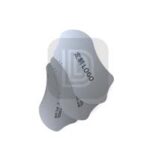With recent advancements, fingerprint recognition technology has become the leading biometric identification method in the smart device and mobile payment markets. Currently, mainstream fingerprint recognition technologies are generally categorized into three types: capacitive, optical, and ultrasonic.
1. Capacitive Fingerprint Recognition Technology
Capacitive fingerprint recognition is the earliest form of fingerprint recognition technology. It works by forming an electric field when a silicon chip contacts the electrolytes in the skin. The sensor can then record the ridges and valleys of the fingerprint to unlock the device. In theory, capacitive fingerprint recognition requires a medium to transmit the data, essentially needing a button-like structure to support it. In the era of full-screen devices, manufacturers have designed this as rear-mounted or side-mounted fingerprint unlocking. However, this type of fingerprint unlocking is sensitive to dryness, meaning that wet fingers cannot unlock the phone, which is why this technology is now rare in the market.
In recent years, user demand has increasingly favored large screens, slim bodies, and sleek designs, and screens have evolved from LCD to OLED. This shift enabled the development of in-display fingerprint recognition based on OLED screens, with sensors placed beneath the screen, giving users a more advanced technological experience during fingerprint recognition.
Currently, in-display fingerprint recognition is implemented using two methods: optical and ultrasonic.

2. Optical Fingerprint Recognition Technology
Optical fingerprint recognition is a popular unlocking technology that represents a leap from capacitive fingerprint recognition by moving the fingerprint sensor onto the screen, saving space on the device. Its principle is straightforward, relying on light reflection and refraction. When a finger presses on the screen, the display emits a bright light onto the fingerprint, which is then reflected and refracted down to the sensor beneath the screen for recognition, unlocking the device.
This technology has matured considerably, and nearly all smartphone manufacturers use it, with user satisfaction being fairly high. However, as with capacitive fingerprint recognition, optical recognition struggles to unlock with wet fingers, and applying certain tempered glass screen protectors may also interfere. These issues are due to light refraction; when water or screen protectors alter the angle of light, recognition can fail. Therefore, many manufacturers recommend using compatible screen protectors to avoid fingerprint unlocking issues.

3. Ultrasonic Fingerprint Recognition Technology
Ultrasonic fingerprint recognition is a newer technology. Its principle relies on reading the pressure from sound waves reflecting off the skin, mapping the fingerprint with sound waves that are recognized by a transducer for unlocking. In theory, compared to the first two unlocking methods, ultrasonic fingerprint recognition uses three-dimensional recording and sound wave transmission, requiring less detail in finger texture. This allows the phone to unlock even if fingers are wet, dirty, or if the screen is damp, without any impact on sensitivity.
Additionally, when registering a new fingerprint, users do not need to press repeatedly; a single press on the fingerprint area is enough to register the fingerprint, allowing for multiple unlocks. This technology effectively addresses common issues of capacitive and optical fingerprint recognition, requiring minimal finger texture detail and enhancing security. However, it still faces a challenge: despite using pressure transmission, ultrasonic fingerprint recognition remains an in-display technology. When a tempered glass screen protector is applied, pressure transmission may be partially blocked, though failures are rare.
Ultrasonic fingerprint recognition has a relatively high cost, and its technology is less mature, leading to lower market adoption. Currently, optical in-display fingerprint recognition remains dominant, but if ultrasonic in-display fingerprint recognition becomes more refined, it may gain a larger share.
If ultrasonic under-screen fingerprint recognition technology and capacitive under-screen fingerprint recognition technology are to develop, they need to solve their respective technical problems as soon as possible.
DT-Smart’s screen fingerprint recognition technology includes three types: capacitive, optical, and ultrasonic. Let’s take a look at the differences between the screens using these three fingerprint recognition technologies through the video below.

















